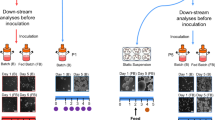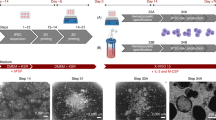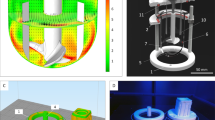Abstract
Induced pluripotent stem cells (iPSCs) are typically derived in adherent culture. Here we report fast and efficient derivation of mouse iPSCs in stirred suspension bioreactors, with and without the use of c-Myc. Suspension-reprogrammed cells expressed pluripotency markers, showed multilineage differentiation in vitro and in vivo, and contributed to the germline in chimeric mice. Suspension reprogramming has the potential to accelerate and standardize iPSC research.
This is a preview of subscription content, access via your institution
Access options
Subscribe to this journal
Receive 12 print issues and online access
$259.00 per year
only $21.58 per issue
Buy this article
- Purchase on Springer Link
- Instant access to full article PDF
Prices may be subject to local taxes which are calculated during checkout


Similar content being viewed by others
References
Takahashi, K. & Yamanaka, S. Cell 126, 663–676 (2006).
Takahashi, K. et al. Cell 131, 861–872 (2007).
Woltjen, K. et al. Nature 458, 766–770 (2009).
Shafa, M. et al. J. Tissue Eng. Regen. Med. advance online publication, doi:10.1002/term.450 (14 July 2011).
Cormier, J.T., zur Nieden, N.I., Rancourt, D.E. & Kallos, M.S. Tissue Eng. 12, 3233–3245 (2006).
zur Nieden, N.I., Cormier, J.T., Rancourt, D.E. & Kallos, M.S. J. Biotechnol. 129, 421–432 (2007).
Krawetz, R. et al. Tissue Eng. Part C Methods 16, 573–582 (2010).
Kirouac, D.C. & Zandstra, P.W. Cell Stem Cell 3, 369–381 (2008).
Sen, A., Kallos, M.S. & Behie, L.A. Brain Res. Dev. Brain Res. 134, 103–113 (2002).
Taiani, J.T. et al. Stem Cells Dev. 19, 989–998 (2010).
Nakagawa, M., Takizawa, N., Narita, M., Ichisaka, T. & Yamanaka, S. Proc. Natl. Acad. Sci. USA 107, 14152–14157 (2010).
Okita, K., Ichisaka, T. & Yamanaka, S. Nature 448, 313–317 (2007).
Nakagawa, M. et al. Nat. Biotechnol. 26, 101–106 (2008).
Acknowledgements
We acknowledge members of The Clara Christie Centre for Mouse Genomics for helping us to derive 129/Sv MEFs and SiPSC chimeras. This research was supported by a Canadian Institute of Health Research Regenerative Medicine and Nanomedicine Team grant (RMF-82497).
Author information
Authors and Affiliations
Contributions
M.S. designed the project, generated and characterized SiPSCs and prepared the manuscript; B.D. performed confocal microscopy and qPCR and prepared the manuscript; A.Y., G.M. and S.L. characterized SiPSCs, R.K. and D.E.R. designed the project and prepared the manuscript.
Corresponding author
Ethics declarations
Competing interests
The authors declare no competing financial interests.
Supplementary information
Supplementary Text and Figures
Supplementary Figures 1–3, Supplementary Tables 1–6 (PDF 339 kb)
Rights and permissions
About this article
Cite this article
Shafa, M., Day, B., Yamashita, A. et al. Derivation of iPSCs in stirred suspension bioreactors. Nat Methods 9, 465–466 (2012). https://doi.org/10.1038/nmeth.1973
Received:
Accepted:
Published:
Issue Date:
DOI: https://doi.org/10.1038/nmeth.1973
This article is cited by
-
Hydrodynamic modulation of pluripotent stem cells
Stem Cell Research & Therapy (2012)
-
Reprogramming in suspension
Nature Methods (2012)



